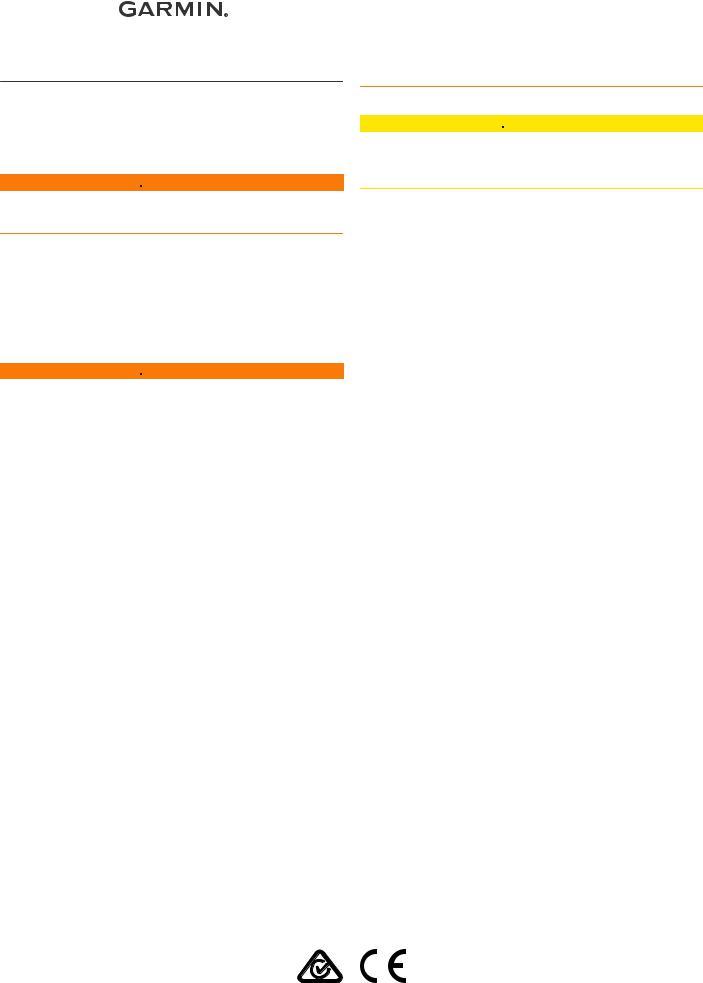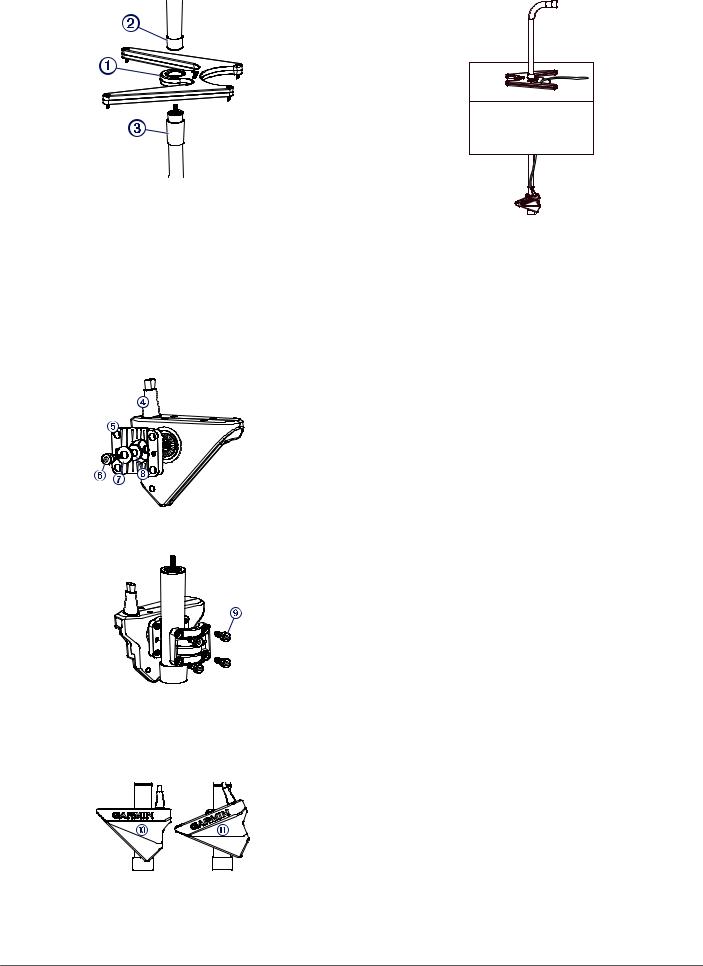Garmin LVS32, GLS 10 User Manual

PANOPTIX™ LIVESCOPE™ ICE
FISHING BUNDLE
INSTALLATION
INSTRUCTIONS
Important Safety Information
 WARNING
WARNING
See the Important Safety and Product Information guide in the chartplotter or fishfinder product box for product warnings and other important information.
To obtain the best performance, you must install the Garmin® device according to these instructions.
Read all installation instructions before proceeding with the installation. If you experience difficulty during the installation, go to support.garmin.com for more information.
Battery Information
Battery Warnings
 WARNING
WARNING
The Garmin device uses a user-replaceable, sealed, lead-acid battery. If these guidelines are not followed, the battery may experience a shortened life span or may present a risk of damage to the device, fire, chemical burn, electrolyte leak, and/or bodily injury.
•Do not place the battery near objects that may cause sparks, flames, or heat.
•Do not incinerate the battery.
•Do not use a sharp object to remove the battery.
•Do not disassemble, puncture, or damage the battery.
•Do not swallow, touch, or inhale the contents of an open battery. Avoid contact with internal acid. Contact with internal acid may cause irritation or severe burns. Irritation may occur to the eyes, respiratory system, and skin. Flush with water at once if contact is made with acid.
•Do not submerge the battery and avoid contact with water.
•Do not short the battery terminals.
•Do not drop or throw the battery.
•Keep the battery away from children.
•Only replace the battery with the correct replacement battery. Using another battery presents a risk of fire or explosion of the device or charger.
•Only charge the battery with the included charger.
•Do not charge the battery in an unventilated area.
•Store in a cool, dry, and well-ventilated area.
•Do not charge the battery in a gas-tight container.
•Do not leave the device exposed to a heat source or in a high-temperature location, such as in the sun in an unattended vehicle. To prevent damage, remove the device from the vehicle or store it out of direct sunlight.
•Do not use organic solvents or other cleaners other than recommended chemical cleaners on the battery.
•Contact your local waste disposal department to dispose of the battery in accordance with applicable local laws and regulations.
•When storing the battery for an extended time, store within the following temperature range: from 5° F to 104°F (from -15° C to 40° C).
•Do not operate the battery outside of the following temperature range: from 5° F to 122° F (from -15° C to 50° C).
Charging the Battery
 CAUTION
CAUTION
Ensure that you connect the correct spade connector to the correct battery terminal. Damage to the battery or device, or bodily harm may occur if the device is improperly connected to the battery.
You should always use the all-in-one cable to charge the battery.
NOTE: The gray + and - connectors on the power cable are for connecting to a PS22 transducer.
1 Remove the battery terminal covers.
2Connect the red and black spade connectors from the all-in- one cable onto the corresponding battery terminals.
3 Connect the all-in-one cable to the wall charger. 4 Connect the wall charger to the wall outlet.
The light on the wall charger is solid orange when the battery is charging. It takes about 10 to 12 hours in a room-temperature environment to fully charge a fully discharged battery. When the light is solid green, the battery is fully charged.
Battery Tips
•The length of time a fully charged battery will last before fully discharging varies based on many factors, such as device backlight brightness, the temperature, and the age of the battery.
•You can lower the backlight brightness level to help extend the battery life.
•The life expectancy of a sealed, lead-acid battery can be extended by frequently recharging and not completely discharging the battery.
•Sealed, lead-acid batteries slowly lose their charge while in storage. For best results, charge the battery prior to use.
•When used in cold temperatures, sealed, lead-acid batteries do not hold the charge as long as in warmer temperatures.
•Sealed, lead-acid batteries are completely recyclable.
Assembling the Panoptix Ice Fishing Mount
You need a Phillips screwdriver and the included 5 mm hex wrench to assemble the ice fishing mount and attach the transducer.
1Insert the Phillips head sheet metal screws into the four corners of the ice mount base.
The screws protrude from the bottom of the base to help stabilize the mount when it is on the ice.
2 Locate the handle and the top pole segment.
3Place the base  between the handle
between the handle  and the top pole
and the top pole  , and screw them together.
, and screw them together.
December 2019 190-02458-92_0B

4Determine how many of the three middle pole segments you need to use, based on the thickness of the ice.
TIP: The top of the transducer must be below the bottom of the ice for best performance.
5Screw together the needed segments, with the shortest segment on the bottom of the pole.
6Use the included hex wrench to attach the transducer  to the bracket
to the bracket  with the shoulder screw
with the shoulder screw  , flat washer
, flat washer  , and rubber washer
, and rubber washer  .
.
NOTE: You must fully tighten the shoulder screw to secure the transducer to the bracket. The recommended torque applied to the shoulder screw is 2.5 lb-ft. (3.4 N-m).
7Using the hex wrench and the M6 screws  , attach the two halves of the bracket around the pole.
, attach the two halves of the bracket around the pole.
8Use the hook and loop straps to secure the transducer cable to the pole.
9Position the transducer for the desired view.
TIP: Turn the mount one click to change the orientation from forward  to down
to down  .
.
10Place the mount base around the hole in the ice.
11Rotate the handle to aim the transducer.
Effective Forward and Down Range
NOTE: Water conditions and bottom conditions affect the depth and range performance of the transducer. You should use caution and observe the water depth and range, especially when your unit is operating in manual range or depth mode.
When operating in LiveVü Forward mode, the transducer has an effective forward range of between five and eight times the depth of the water. For example, in 3 m (10 ft.) of water, the effective forward range is between 15 and 24 m (between 50 and 80 ft.). Water conditions and bottom conditions affect the actual range.
When operating in LiveVü Down mode, the fore/aft range is equal to the depth of the water. For example, in 10 m (33 ft.) water depth, the screen will display 5 m (16 ft.) fore and 5 m (16 ft.) aft of the transducer. Deeper water provides a greater fore and aft range.
Specifications
Ice Fishing Bundle Specifications
Specification |
Measurement |
Battery type |
Sealed, lead acid, 12 Ah |
Battery life |
Up to 7 hr. |
|
NOTE: The actual battery life of a fully charged |
|
battery can vary based on the device used, |
|
backlight brightness, temperature the battery is |
|
operated and stored in, age of the battery, and |
|
depth of the water. |
|
|
Battery shelf life |
1 mo.: 92% |
after charging |
3 mo.: 90% |
|
6 mo.: 80% |
|
|
Battery operating |
From 5° to 122°F (from -15° to 50°C) |
temperature range |
|
Battery charging |
From 5° to 104°F (from -15° to 40°C) |
temperature range |
|
Battery storage |
From 5° to 104°F (from -15° to 40°C) |
temperature range |
|
Physical size, |
13.8 × 12.2 × 13.0 in. (35 × 31 × 33 cm) |
assembled kit with |
|
device (L × W × H) |
|
Weight without |
23.14 lb. (10.5 kg) |
device |
|
Battery Discharge Specifications
Temperature |
Screen brightness |
Time |
At 0°C (32°F) |
100% |
5.6 hr. |
At 0°C (32°F) |
50% |
7.5 hr. |
|
|
|
2
